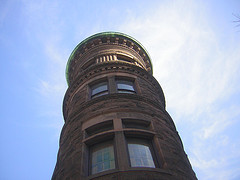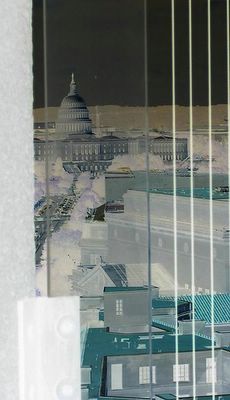HEURICH HOUSE: Staring Down a Auction
 (Editor's Note: This is long blog post, but I hope that you do read through it in full.)
(Editor's Note: This is long blog post, but I hope that you do read through it in full.)AS YOU'VE READ in this blog for the past two weeks or so, you should by now definitely recognize why Washington, D.C.'s Heurich House -- aka the Brewmaster's Castle -- is important and should be saved as the United States' most-intact late Victorian home museum (regardless of my personal sentimental feelings for my great-great grandfather's role in crafting the 31-room home's interior).
For background on the house and the situation, here are some quick links:
- "Help Save the Castle" [Brewmaster's Castle]
- "Racing to Save a Victorian Gem" [The Washington Post]
- "OF URGENT IMPORTANCE: Preserving the Public's Access to the Historic Heurich House" [The Washington Oculus]
EXPLAINING THE CURRENT CRISIS to those unfamiliar with the capital's most-secret museum gem, one thing I stress is that as Washington has grown over generations from a sleepy provincial town on the banks of the Potomac to a center of global power largely populated by transient outsiders (including yours truly ... though I don't like to think of myself as transient) the natural civic constituency that would normally come to the rescue has not been immediately present. The Heurich House is not the Decatur House, it isn't the Octagon House, nor is it Tudor Place. The Brewmaster's Castle lacks an overarching federal story that would typically draw Congressional appropriations or corporate philanthropic dollars with relative ease.
As a member of the merchant class, Christian Heurich -- and to a lesser extent August Grass, my great-great grandfather -- was someone who helped build this city. He wasn't one of capital's more famous inhabitants who helped build this nation while residing here. But that doesn't mean the significance of Mr. Heurich and many others like him should be forgotten about by locals or ignored by newcomers.
MR. HEURICH'S MAGNIFICENT RESIDENCE is a testament to a successful upper middle class businessman. Mr. Heurich was a simple, hard-working brewer -- not a naval hero, not a granddaughter of Martha Washington, not even a Gilded Age mining millionaire turned politician, though one did live across the street (California Sen. William Hearst).
 While there is no grand federal story associated with 1307 New Hampshire Ave., Mr. Heurich's grandson, Gary Heurich, did relate a very interesting story as I was helping him guide visitors through the house on Saturday afternoon. And it actually involves the national history of this city and country. It also illustrates the present-day threat the house faces.
While there is no grand federal story associated with 1307 New Hampshire Ave., Mr. Heurich's grandson, Gary Heurich, did relate a very interesting story as I was helping him guide visitors through the house on Saturday afternoon. And it actually involves the national history of this city and country. It also illustrates the present-day threat the house faces.IN 1868, CHRISTIAN HEURICH was living briefly in Kansas and for the first and only time, was able to vote for president. (Mr. Heurich, who died in 1945, was never able to see the day when residents of the District of Columbia were granted the right to vote for the guy who lived in one of Pennsylvania Avenue's more fashionable residences.) In that election 138 years ago, Heurich cast his vote for Ulysses S. Grant in a county where the margin of victory was just two votes. Mr. Heurich liked to think that his vote got Mr. Grant into the White House.
So when Heurich was back in Washington, he was no doubt eager to bid at auction on a one-of-a-kind three-sided roll-top desk intended for President Grant. (It was crafted by an admirer in the Montana Territory but the U.S. government refused to pay for shipping, so it went to auction instead.) Mr. Heurich outbid everyone and it became a prized possession. Today, President Grant's desk sits in the Exhibition Room of the Brewmaster's Castle.
 THE TRAGIC IRONY here is, of course, that the historic desk Mr. Heurich bought at auction years ago could very likely end up on the auction block in the near future, unless the coalition of concerned citizens trying to save the Brewmaster's Castle -- including your friendly blogger here -- is successful in its fundraising efforts.
THE TRAGIC IRONY here is, of course, that the historic desk Mr. Heurich bought at auction years ago could very likely end up on the auction block in the near future, unless the coalition of concerned citizens trying to save the Brewmaster's Castle -- including your friendly blogger here -- is successful in its fundraising efforts.The threat is clear. While the exterior of the Heurich House is indeed protected as a landmark on the National Register for Historic Places, the future of the interior is not secure. That means an embassy could come in and paint over "The Young Year and the Expiring Year" (Detlef Sammann's painting on the Parlor's ceiling.) That means that the 1901 Steinway piano in the Music Room that was painted to match the French Revival design scheme of the first floor's formal rooms could be carted away. That means that the Dining Room's exquisitely carved griffin-legged table seating 18 people (which matches the themes seen in August Grass' woodcarvings on the sideboard and the fireplace) could be poked and prodded in Kansas City's convention center as part of an "Antiques Roadshow" Ask the Expert session in a generation or two or three.
 FOR THOSE WHO KNOW the history of Frank Lloyd Wright's Meyer May House in Grand Rapids, Mich., it took millions of dollars by a corporation to meticulously recreate and reassemble the Prairie-style home museum's furniture, fabrics and carpeting (seen here). Mr. Wright's Robie House near the University of Chicago -- the quintessential Prairie style home -- has suffered from the fact that its full assembly of furniture and decorations has been scattered and in some instances lost. It took millions of corporate philanthropy by the Steelcase Corp. to recreate the Meyer May House. It is taking an "Adopt an Artifact" effort to recreate and restore the Robie House's interior. Fortunately for the Heurich House, its interior is intact, largely untouched over the past century.
FOR THOSE WHO KNOW the history of Frank Lloyd Wright's Meyer May House in Grand Rapids, Mich., it took millions of dollars by a corporation to meticulously recreate and reassemble the Prairie-style home museum's furniture, fabrics and carpeting (seen here). Mr. Wright's Robie House near the University of Chicago -- the quintessential Prairie style home -- has suffered from the fact that its full assembly of furniture and decorations has been scattered and in some instances lost. It took millions of corporate philanthropy by the Steelcase Corp. to recreate the Meyer May House. It is taking an "Adopt an Artifact" effort to recreate and restore the Robie House's interior. Fortunately for the Heurich House, its interior is intact, largely untouched over the past century.The Heurich House is meant to be a museum, open for tours in the public domain, like is has been for the past half century. It would be a shame if the contents of the Brewmaster's Castle would be scattered to be scooped up by ruthless antiques hawkers.
ALL IN ALL, it would be a shame for the Heurich House to be lost -- largely forgotten by the city Mr. Heurich helped build or ignored by the larger population of newcomers who often grow too comfortable viewing their new home as an amusement park in which to make money or forge a career. In the name of history, it is a cause worth fighting for.
If you can, please donate at BrewmastersCastle.com.
First two photos from Rob Goodspeed, via Flickr. Third photo by Michael Grass, via Flickr. Meyer May House interior from dgunning.org



1 Comments:
Semua ada disini game terlengkap dan tergacor RTP Vodka138
Post a Comment
<< Home